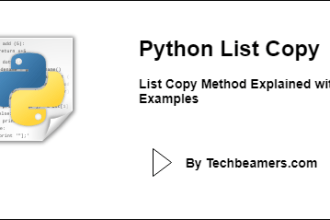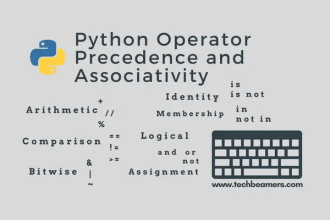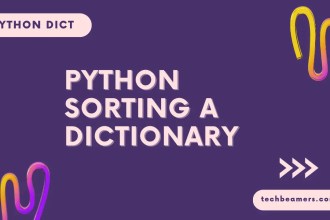In this tutorial, we’ll explain the difference between Python map vs list comprehension. Both map and list comprehensions are powerful tools in Python for applying functions to each element of a sequence. However, they have different strengths and weaknesses, making them suitable for different situations. Here’s a breakdown:
The Difference Between Python Map vs List Comprehension
Before drawing a comparison, let’s first understand what exactly we can do with the Python map and list comprehension.
Map Function
The map function is a tool that helps you efficiently apply a specified function to each item in an iterable and collect the results. It’s a handy way to avoid writing loops and make your code more concise.
Imagine you have a list of numbers and you want to double each of them. Instead of using a loop, you can use the map function. It’s a quick way to say, “Hey Python, take this function and apply it to each number in my list.”
| Syntax: | map(function, iterable) |
| Function arguments: | One function and one iterable (list, string, etc.). |
| Returns: | An iterator, not a list directly. You need to call list on the result to get an actual list. |
| Filtering not built-in: | Requires separate filter function if you want to apply conditions. |
| Good for: | – Using an existing, named function repeatedly. – Parallel processing with libraries like multi-processing or concurrent futures. |
Simple Map Example
Let’s get the map working to extract initials:
names = ["Ram Sinha", "Archita Kalia", "John Dorthy"]
initials = list(map(lambda name: name[0] + "." + name[name.find(" ") + 1], names))
print(initials)
# Result: ['R.S', 'A.K', 'J.D']List Comprehension
In Python, list comprehension is a cool trick that helps you quickly make a new list from an old one. It’s like a shortcut for doing the same thing to each item in a group (like a list).
For example, let’s say you have a list of numbers, and you want to double each number. Instead of using a big loop, you can use list comprehension. It’s a short and snappy way to tell Python what you want to do with each number in the list.
| Syntax: | [expression for item in iterable [if condition]] |
| Function arguments: | It is a composite statement to express the entire operation in a single line. |
| Returns: | Returns a list directly. |
| Filtering: | Built-in, it can include conditional statements (i.e., if clause) for filtering elements. |
| Good for: | – Simple or complex transformations with filtering. – Improving code readability and conciseness. |
Simple LC Example
Let’s see how to get the LC expression to filter the initials.
names = ["Jake Li", "True Man", "Rani Didi"]
data = [name[0] + "." + name[name.find(" ") + 1] for name in names]
print(data)
# Result: ['J.L', 'T.M', 'R.D']Let’s try to understand the difference between Python map vs list comprehension by using examples.
Compare Map vs List Comprehension
Let’s compare map and list comprehension in a head-to-head manner using examples:
Example1: Cubing Numbers
Let’s do some maths and try to calculate the cube of each number in a list.
List Comprehension:
seq = [1, 2, 3, 4, 5]
lc_out = [x**3 for x in seq]
print(lc_out)
# Result: [1, 8, 27, 64, 125]map Function:
def cube(z):
return z**3
ints = [1, 2, 3, 4, 5]
map_out = list(map(cube, ints))
print(map_out)
# Result: [1, 8, 27, 64, 125]Comparison:
- Both approaches achieve the same result.
- List comprehension is more concise and readable for this simple transformation.
Example2: FilterEven Numbers
Let’s square those numbers from the list that are even.
List Comprehension:
num_list = [1, 2, 3, 4, 5]
lc_out = [x**2 for x in num_list if x % 2 == 0]
print(lc_out)
# Result: [4, 16]map Function:
def square_if_even(x):
return x**2 if x % 2 == 0 else None
nums = [1, 2, 3, 4, 5]
map_out = list(map(square_if_even, nums))
map_out = [x for x in map_out if x is not None]
print(map_out)
# Result: [4, 16]Comparison:
- List comprehension remains concise and readable, handling both filtering and transformation in a single line.
- The
mapfunction requires a separate function definition and an additional step to filter outNonevalues, making it less elegant for this scenario.
Example3: Combin Two Lists
Let’s try to add up corresponding elements in two lists.
List Comprehension:
nums1 = [0.01, 0.02, 0.03]
nums2 = [0.04, 0.05, 0.06]
final = [x + y for x, y in zip(nums1, nums2)]
print(final)
# Result: [0.05, 0.07, 0.09]map Function:
def adder(x, y):
return x + y
seq1 = [0.1, 0.2, 0.4]
seq2 = [0.4, 0.5, 0.6]
out = list(map(adder, seq1, seq2))
print(out)
# Result: [0.5, 0.7, 1.0]Comparison:
- List comprehension is more concise, and the zip function seamlessly allows combining elements from two lists.
- The
mapfunction requires a separate function definition, which might be overkill for this straightforward operation.
Example4: Data Cleaning Challenge
Imagine you have a CSV file containing product info with inconsistent price formats (e.g., “$10.99”, “10.99”, “£10.99”). Your goal is to clean the data and convert all prices to a consistent format like “10.99”.
Solution A: Using map
import csv
# Write a function for price cleaning
def clean_price(price_str):
new_price = price_str.strip().replace("$", "").replace("£", "")
try:
price = float(new_price)
except ValueError:
return None
return f"{price:.2f}"
# Apply the clean_price function to each price using map and write result to a new file
with open("prod.csv", "r") as infile, open("new_prices.csv", "w") as outfile:
rr = csv.reader(infile)
wr = csv.writer(outfile)
wr.writerow(next(rr)) # Write header row
for row in rr:
new_prices = list(map(clean_price, row))
wr.writerow(new_prices)Solution B: Using LC
import csv
# Apply price cleaning and prepare the cleaned list using list comprehension
with open("prod.csv", "r") as infile, open("new_prices.csv", "w") as outfile:
rr = csv.reader(infile)
wr = csv.writer(outfile)
wr.writerow(next(rr)) # Write header row
for row in rr:
cleaned_prices = [f"{float(price.strip().replace('$', '').replace('£', '')):.2f}" if price else None for price in row]
writer.writerow(cleaned_prices)Review:
- Clarity: List comprehension offers a shorter, more concise approach for this simple cleaning task.
- Flexibility: Separate functions with the map might be easier to reuse or modify for different cleaning needs.
- Performance: For complex cleaning logic, a map might have a slight advantage due to function caching.
Feature Comparison
Let’s now compare the two from a different dimension. Here, we are taking some of the code quality factors for comparison.
| Feature | Python map | List Comprehension |
|---|---|---|
| Syntax | map(function, iterable) | [expression for item in iterable [if condition]] |
| Return type | Iterator | List |
| Built-in filtering | No (requires separate filter function) | Yes (if condition) |
| Readability | Moderate (less with complex lambdas) | More concise and Pythonic |
| Performance | Faster with pre-defined functions | Faster with complex expressions/lambdas |
| Memory usage | Slightly less (lazy evaluation) | Slightly more |
| Error handling | Exceptions raised within function/expression | Same as above |
| Use cases | To apply existing functions repeatedly, support parallel processing | Simple/complex transformations with filtering, concise code |
| Example | map(lambda x: x*2, [1, 2, 3]) | Applying existing functions repeatedly, parallel processing |
Additional notes:
I hope this table provides a clear comparison of the key features of map and list comprehensions. Choose the right tool for the job to write efficient and expressive Python code!
Related: Is Python Map Faster than Loop?
Recap
Congratulations on completing this tutorial. Let’s quickly recap what you learned today.
List Comprehension:
Map Function:
Summary: Map vs List Comprehension
Ultimately, the choice between list comprehension and map depends on the specific use case and the complexity of the operation you need to perform. Both have their strengths and are valuable tools in Python programming.
Python has many features that compete with each other. You must understand their differences. So that, it is easy for you to choose the right one from them.
Python vs C++ – Understand the Differences
Python Sets vs Lists – Check Out the Differences
Generators vs List Comprehensions in Python
Difference Between List Append and Extend
Python XRange vs Range Differences
Shallow Copy vs. Deep Copy in Python
Lastly, our site needs your support to remain free. Share this post on social media (Linkedin/Facebook) if you gained some knowledge from this tutorial.
Enjoy coding,
TechBeamers.






